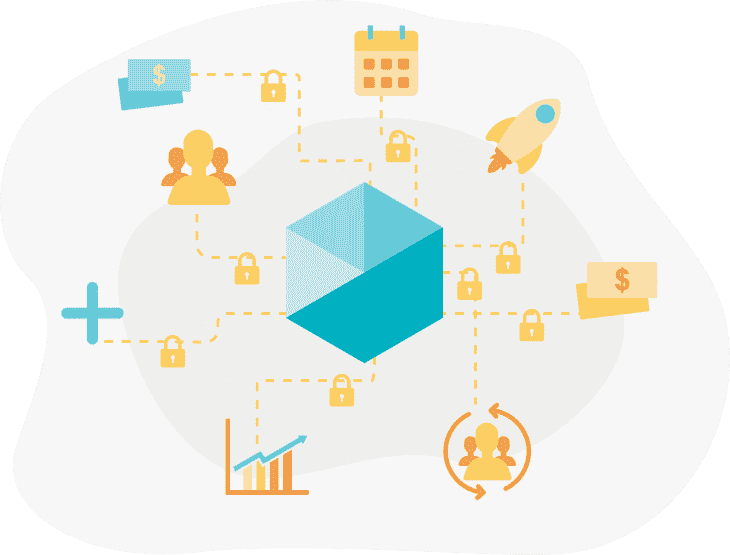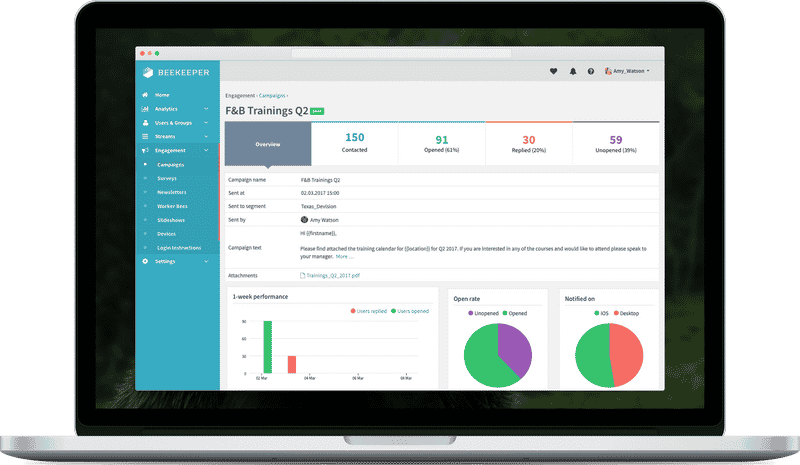Table of contents
- What Does Organizational Change Really Mean?
- Rethink Your Organizational Processes
- What Are Change Management Tools and Techniques?
- How to Foster Digital Adoption in Your Organization
- Internal Communications Designed for Adaptability
- A Workforce Solution That Builds Trust Through Transformation and Fearless Change
- Digital Change Management Simplifies Workforce Tasks
- Most Frequently Asked Questions
Everyone wants to be a change maker at their company nowadays. Buzzwords like “disrupter,” “maverick” and “influencer” have helped catapult business leaders with divisive ideas to celebrity-like status on platforms like LinkedIn and Medium.
What Does Organizational Change Really Mean?
The reality is that having big, bold ideas is one thing. Creating organizational change within a company is something else entirely. It requires more than a mildly polarizing LinkedIn post. To truly create real change, leaders must be willing to get down in the weeds. To get messy. To hear uncomfortable truths.
And above all else, true change makers need to engage, really engage with their frontline employees.
Here’s how.
Rethink Your Organizational Processes
If you’re transitioning from a top-down leadership style to one that’s more inclusive, there are few actions to take to make sure that your team is on the same page. It’s important to connect directly with your employees and get their feedback, insights, and ideas.
Get Employees Involved

The best way to get your employees more engaged, involved, and invested in your organization is by embracing a bottom-up approach to your internal communication.
Employees are your greatest asset. Your company’s success depends on their engagement. But they’re often overlooked when companies make big decisions. For instance, when companies are negotiating a merger or acquisition, failure is often attributed to “people and organizational issues.”
Change Management Principles and Methodologies:
- Make sure leadership is informed and invested. Executive buy-in is the first step to successful change management. If your leadership doesn’t have mandatory discussions about their role in change management, it won’t work. When leadership models positive technology adoption behaviors, they align themselves with their workforce through actively demonstrating the technology’s value.
- Ensure the tools for your change management program reach everyone. Your change management tools should be aligned with your company’s goals, but it also needs to reach every single member of your workforce. Using a digital workplace app like Beekeeper combines some of the most-used internal communication tools for shift management, payroll, unified communications, and employee engagement.
- Consider consulting with change management professionals. When it comes to change management principles methodologies and tools, adoption relies on implementation. Why not bring in change management experts who can guide you step-by-step through your digital workforce transformation?
What Are Change Management Tools and Techniques?
To put it simply, change management tools are meant to bring a sense of order to the often chaotic environment that ensues when a company is going through serious organizational change.
Use cases of tools for change management include:
- Approval management automation
- A critical event calendar
- SLA management tracking
- Visual mapping
- Incident reporting
- Process auditing
- Departmental alignment
Your change management tools should. . .
- Be fully customizable
- Easy to navigate
- Offer intuitive UX
- Bring your organization together during a chaotic time and soothe departmental divides
How to Foster Digital Adoption in Your Organization
Change can be scary. Implementing new tools comes with a wide array of challenges. Some people just don’t like technology. Some people find it difficult to learn new software programs. And some people really, really liked the tool they were using before, and they don’t want to switch to a platform they don’t know.
Here’s how to overcome your team’s resistance to new tech.

Overcome Barriers to Workforce Adoption of Digital Technology
Familiarity and ease-of-use are both essential factors when it comes to workforce adoption of new workplace technology. People want to use communication tools they are familiar with. From a consumer standpoint, it’s safe to assume most frontline employees talk to family and friends through messaging on mobile devices that is extremely intuitive.
If a company can’t make their messaging app easy and desirable to use, they simply won’t use it. Moreover, the employee app experience needs to prove its value by being integrated into their daily workflows and becoming an asset to their job.
Companies evolve in any number of ways: new leadership, rapid growth, a merger, or an acquisition. In order to adapt, companies need a stabilizing force during a time of flux. Whatever the catalyst for change, an internal communications platform can:
- Support your operations
- Foster unified communication
- Align and prepare your employees for what’s to come
- Avoid workflow interruptions by bridging communication gaps
Partnered with the right digital tools, an internal communications strategy delivers high-performance results, ranging from improved employee engagement and productivity to customer satisfaction.
Maintain Continuity in Operational Communications
During corporate reorganization, workflows are easily interrupted, and operational communications can all but shut down. A digital workforce solution becomes that stabilizing force to bridge communication. So while changes might be happening to your external environment, your internal structure and operational communication remain resilient and intact.
FRHI Hotels and Resorts is a company that has learned to thrive through change. What started out as one luxury hotel has evolved through mergers and acquisitions into a corporation that runs 125 properties around the world with 45,000 employees.
Watch how FRHI uses Beekeeper to engage their entire team!
To provide continuity of operational communications through growth, they used Beekeeper for internal communication change management to avoid any interruptions to workflows and guest service.
Beekeeper has become the primary platform to deliver company news, updates, and any kind of executive communication.”
Alexandra Zeifman
Internal Communications, Project Manager, FRHI
With its intuitive UX, Beekeeper was quickly adopted by new FRHI properties and teams. The app’s inline translation feature allows employees in any of the company’s 30 countries to fully participate from day one, enabling seamless communication as the company continues to grow.
Dynamic Analytics Dashboard to Measure ROI
With an analytics dashboard, you can get actionable data on employee engagement, open rates, and workforce feedback on all team app content that benefits every level of your organization from HR to operations.
Organizations can leverage these insights to improve operational communications, implement new policy or procedural changes, and boost overall workplace culture.ions for smartphones, tablets, and laptops, it doesn’t make much sense to lock your retail employees into a specific device or operating system anymore. Almost all software and apps are compatible with Android and Apple operating systems. This gives you and your retail employees the freedom to communicate on the devices you’re most comfortable with.

Employers can also directly measure the ROI of the team app by assessing the impact of campaigns and related content on internal communications, employee retention, and operational efficiency.
Internal Communications Designed for Adaptability
During any time of organizational transition, your operational communications need to be leadership-led and as solid as possible. Consider a digital workforce solution, like a team app, with the following that reaches every employee for solid, unified communication so nobody feels left in the dark.
- Mobile-first solution. A team app levels the playing field with mobile-first design to deliberately reach frontline workers who have long been excluded from traditional internal communications.
- Low barrier to entry. Avoid technology with too many functionalities and steep learning curves that will only “confuse and lose” your employees. Look for a straightforward rollout strategy and easy interface to keep operational communications and workflows running smoothly throughout a company’s metamorphosis.
- Scalability. Whether your workforce size expands or you add locations halfway around the world, you need an agile platform that will ebb and flow with corporate evolutions.
- Customer success support. Your investment in a team app should include customer success support that carries through beyond rollout.
A Workforce Solution That Builds Trust Through Transformation and Fearless Change

The unknowns of workplace changes can create dynamics that contribute to a worried, distracted workforce. Needless to say, productivity is often the first area that takes a hit. People want, and deserve, to know pertinent information such as the fate of their jobs, or changes to their schedule.
Bringing your workforce together with a team app is a critical step towards transparency by including them in relevant messaging, eliminating ambiguity, and earning their trust.
Most workforce solutions only reach knowledge workers. For full workforce alignment, business leaders need to connect every single employee, from your CEO to your frontline workforce, to give everyone a sense of ownership in change management.
Improved employee engagement during change is a vital ROI marker since you need employee buy-in to increase the odds of success.
Preparation is crucial to the successful merger of company cultures. A team app helps companies plan workforce integration before they become a centralized entity by minimizing disruptions and allowing people to work together as a team from day one.
Beekeeper has become the primary platform to deliver company news, updates, and any kind of executive communication.”
When it comes to effective change management, any organization that is looking to implement a successful digital transformation needs to communicate the ongoing changes with everyone.
This is especially true when it comes to change management with primarily non-desk workforces; achieving workforce-wide adoption of new technology can be particularly challenging when workers aren’t accustomed to receiving information via digital methods.
Deploying an employee app to handle workforce change management can:
- Ensure messaging is clearly communicated in real-time to all employees
- Easily allow organizations to push updates to teams across shifts, time zones, and departments
- Provide detailed analytics to measure employee engagement and communication
Digital Change Management Simplifies Workforce Tasks
Above all, change management tools should make everyone’s lives easier. Change management and employee buy-in requires an agnostic approach to technology. Not every person in your workforce is going to embrace digitized workflows.
Therefore, your chosen digital workforce strategy needs to be easily integrated with other traditional internal communications strategies to effectively reach all employees or audiences.
At the end of the day, real change within an organization should start from the bottom up and include every single employee — from the CEO to cashier. Equipped with the right change management tools and techniques, anything is possible.
Does your company have an internal communication strategy for change management?
Most Frequently Asked Questions
What are change management tools and techniques?
To put it simply, change management tools are meant to bring a sense of order to the often chaotic environment that ensues when a company is going through serious organizational change.
What are the best change management tools?
1. Approval management automation
2. A critical event calendar
3. SLA management tracking
4. Visual mapping
5. Incident reporting
6. Process auditing
7. Departmental alignment

About the author
Beekeeper
We make frontline lives easier, work safer, and teams more connected so businesses can reach new heights. At Beekeeper, we’re dedicated to making frontline lives easier by connecting workers with the tools, support, and information they need to feel valued, do their best work, and drive the business forward.








